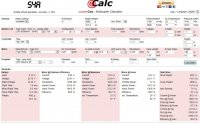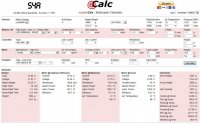gtranquilla
RadioActive
For DIY individuals and others looking to control MR hardware costs, here is a motor comparison between the Tarot and the Turnigy Multistar Pancake style motors using eCalc. Both motors offer thrust and efficiencies that are in the same ballpark as the original DJI - S800 motors. Please advise me if you find any data entry errors. Pancake style Turnigy Multistar 420kv motors were compared by means of eCalc with the conventional design Tarot 4114/320kv motors. The Tarot motors are supposed to be a close substitute to those provided by DJI for their S800 system. Both motors are available at a greatly reduced price (relative quality not determined here).View attachment 13110View attachment 13111
Theoretically the slower rpm motors are considered to be more efficient but Turnigy Multistar motors in the 22 pole configuration are not currently available in the 320kv configuration.
The difference in motor weights is essentially insignificant from the perspective of eCalc calculations. (Tarot motor are 148 grams - Turnigy Multistar motors are 154 grams each). But the Tarot motors also have heat sink and/or fan cooling designed in.
MOTOR DATA:
Tarot motor data was obtained from the following source:
http://www.tarot-rc.com/index.php?m...id=249&zenid=56006abf5c888f84e8f9a4154f6e1e09
Turnigy Multistar data was readily available from HobbyKing.com
ADDITIONAL DETAILS: The Tarot motors are of the same length to width ratio as those used on the S800 with a diameter of 0.31 mm. The Turnigy Multistar motors are the newer pancake design which means a larger diameter relative to motor height, i.e., 0.475mm diameter. Theoretically the pancake motors are supposed to be more efficient by enabling greater magnetic torque due to increased coil radius. Unfortunately ECalc does not take the motor coil radius into account yet.
There was a noticable improvement in MR system efficiency, especially with the Tarot motors when changing the prop pitch to 5 versus the original 5.5 inch pitch.
CONCLUSION: The pricing on the Multistar and the Tarot motors is close. There appears to be some slight efficiency gains when using the Tarot for this MR AUW (designed to carry a GoPro3 c/w 2 axis RCTimer GoPro BGC c/w video downlink and the S800 fixed landing gear) likely the result of a lower 320kv. However it is not possible using eCalc to accurately assess the benefits of the larger diameter pancake style motors which, in theory, are a more efficient design.
Theoretically the slower rpm motors are considered to be more efficient but Turnigy Multistar motors in the 22 pole configuration are not currently available in the 320kv configuration.
The difference in motor weights is essentially insignificant from the perspective of eCalc calculations. (Tarot motor are 148 grams - Turnigy Multistar motors are 154 grams each). But the Tarot motors also have heat sink and/or fan cooling designed in.
MOTOR DATA:
Tarot motor data was obtained from the following source:
http://www.tarot-rc.com/index.php?m...id=249&zenid=56006abf5c888f84e8f9a4154f6e1e09
Turnigy Multistar data was readily available from HobbyKing.com
ADDITIONAL DETAILS: The Tarot motors are of the same length to width ratio as those used on the S800 with a diameter of 0.31 mm. The Turnigy Multistar motors are the newer pancake design which means a larger diameter relative to motor height, i.e., 0.475mm diameter. Theoretically the pancake motors are supposed to be more efficient by enabling greater magnetic torque due to increased coil radius. Unfortunately ECalc does not take the motor coil radius into account yet.
There was a noticable improvement in MR system efficiency, especially with the Tarot motors when changing the prop pitch to 5 versus the original 5.5 inch pitch.
CONCLUSION: The pricing on the Multistar and the Tarot motors is close. There appears to be some slight efficiency gains when using the Tarot for this MR AUW (designed to carry a GoPro3 c/w 2 axis RCTimer GoPro BGC c/w video downlink and the S800 fixed landing gear) likely the result of a lower 320kv. However it is not possible using eCalc to accurately assess the benefits of the larger diameter pancake style motors which, in theory, are a more efficient design.
Attachments
Last edited by a moderator:


